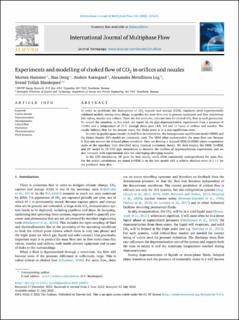| dc.contributor.author | Hammer, Morten | |
| dc.contributor.author | Deng, Han | |
| dc.contributor.author | Austegard, Anders | |
| dc.contributor.author | Log, Alexandra Metallinou | |
| dc.contributor.author | Munkejord, Svend Tollak | |
| dc.date.accessioned | 2022-10-05T09:22:09Z | |
| dc.date.available | 2022-10-05T09:22:09Z | |
| dc.date.created | 2022-08-12T10:49:46Z | |
| dc.date.issued | 2022 | |
| dc.identifier.issn | 0301-9322 | |
| dc.identifier.uri | https://hdl.handle.net/11250/3023978 | |
| dc.description.abstract | In order to accelerate the deployment of capture and storage (CCS), engineers need experimentally validated models, among other things, to predict the mass flow rate in process equipment and flow restrictions like valves, nozzles and orifices. There are few available, relevant data for choked flow in such geometries. To amend the situation, in this work, we report on six pipe-depressurization experiments from a pressure of 12 MPa and a temperature of 25 °C through three sizes (4.5, 9.0 and 12.7 mm) of orifices and nozzles. The results indicate that for the present cases, the choke point is at a non-equilibrium state. In order to predict quasi-steady choked flow in restrictions, the homogeneous equilibrium model (HEM) and the Henry–Fauske (HF) model are commonly used. The HEM often underpredicts the mass flow rate because it does not account for delayed phase transition. Here we develop a delayed HEM (D-HEM) where evaporation starts at the superheat limit described using classical nucleation theory. We then employ the HEM, D-HEM, and HF model in 1D CFD pipe simulations to describe the outflow of depressurization experiments and we also compare with experimental data for converging–diverging nozzles. In the CFD simulations, HF gave the best results, while HEM consistently underpredicted the mass flux. For the nozzle calculations, we found D-HEM to be the best model with a relative absolute error of 2.5 % for the predicted mass flux. | en_US |
| dc.description.abstract | Experiments and modelling of choked flow of CO2 in orifices and nozzles | en_US |
| dc.language.iso | eng | en_US |
| dc.publisher | Elsevier | en_US |
| dc.rights | Navngivelse 4.0 Internasjonal | * |
| dc.rights.uri | http://creativecommons.org/licenses/by/4.0/deed.no | * |
| dc.title | Experiments and modelling of choked flow of CO2 in orifices and nozzles | en_US |
| dc.title.alternative | Experiments and modelling of choked flow of CO2 in orifices and nozzles | en_US |
| dc.type | Peer reviewed | en_US |
| dc.type | Journal article | en_US |
| dc.description.version | publishedVersion | en_US |
| dc.rights.holder | The Authors | en_US |
| dc.source.volume | 156 | en_US |
| dc.source.journal | International Journal of Multiphase Flow | en_US |
| dc.identifier.doi | 10.1016/j.ijmultiphaseflow.2022.104201 | |
| dc.identifier.cristin | 2042633 | |
| dc.relation.project | Norges forskningsråd: 257579 | en_US |
| dc.relation.project | Norges forskningsråd: 225868 | en_US |
| dc.source.articlenumber | 104201 | en_US |
| cristin.ispublished | true | |
| cristin.fulltext | original | |
| cristin.fulltext | preprint | |
| cristin.fulltext | preprint | |
| cristin.qualitycode | 1 | |

